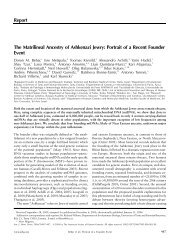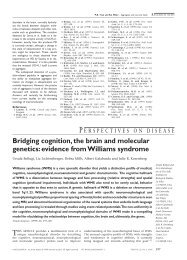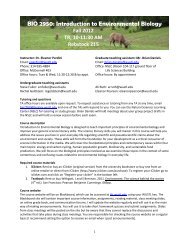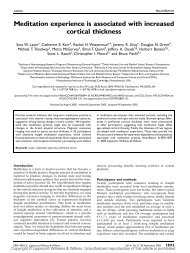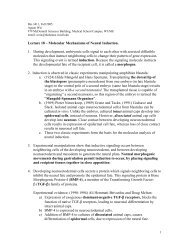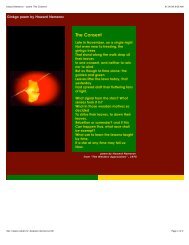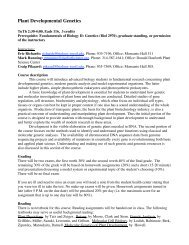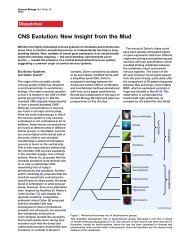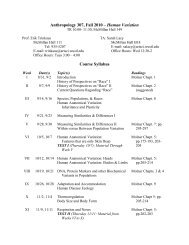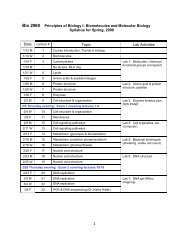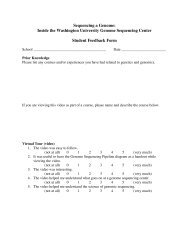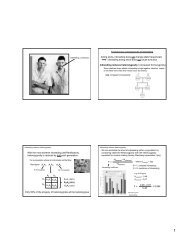The exceptional brain of Albert Einstein
The exceptional brain of Albert Einstein
The exceptional brain of Albert Einstein
Create successful ePaper yourself
Turn your PDF publications into a flip-book with our unique Google optimized e-Paper software.
DEPARTMENT OF MEDICAL HISTORY<br />
<strong>Einstein</strong> Control group (mean, SD)<br />
Left Right Left Right<br />
Age (yr) 76 57 (11)<br />
Height (cm) 176 178 (8)<br />
Overall <strong>brain</strong> measures<br />
1 Brain weight, fresh (g) 1230 1400 (118)*<br />
2 Hemisphere weight, fixed (g) 550·0 545·0 591·0 (46·0) 591·0 (48·0)<br />
3 Maximum height <strong>of</strong> hemisphere 8·9 8·7 9·3 (0·6) 9·4 (0·6)<br />
(cm)†<br />
4 Length <strong>of</strong> hemisphere (OF) (cm) 17·2 16·4 16·9 (0·6) 16·8 (0·6)<br />
5 Maximum width <strong>of</strong> hemisphere 7·5§ 7·5§ 6·5 (0·5) 6·5 (0·5)<br />
(cm)‡<br />
6 Ratio <strong>of</strong> width <strong>of</strong> hemisphere to 0·84§ 0·86§ 0·70 (0·07) 0·69 (0·07)<br />
height<br />
7 Ratio <strong>of</strong> width <strong>of</strong> <strong>brain</strong> to length 0·89§ 0·77 (0·06)<br />
(mean OF)<br />
8 Corpus callosum area (cm 2 ) 6·8 7·0 (0·90)<br />
Frontal lobe (cm)<br />
9 F-PreC 9·2 9·5 9·4 (0·7) 9·2 (0·8)<br />
10 FC 11·3 11·6 10·6 (0·6) 10·5 (0·6)<br />
11 FA 5·1 5·1 4·8 (0·4) 4·7 (0·4)<br />
12 A-PreC 1 0·8 0·9 0·9 (0·4) 1·0 (0·4)<br />
13 PreC 1-C 1 1·2 1·2 1·4 (0·5) 1·2 (0·4)<br />
Temporal lobe (cm)<br />
14 TO 13·2 12·8 13·2 (0·5) 13·2 (0·5)<br />
15 C 1-C 2 3·9 3·9 4·0 (0·3) 4·0 (0·3)<br />
16 SS 1 6·1 6·6 5·1 (1·1) 6·0 (0·9)**<br />
Parietal/occipital lobe (cm)<br />
17 O-PC 8·4 7·9 8·3 (0·8) 8·4 (0·8)<br />
18 OC 8·9 8·3 9·5 (0·6) 9·3 (0·8)<br />
19 OB 7·1 7·9 5·8 (0·9) 7·2 (0·9)**<br />
20 OS 8·0 7·9 6·1 (1·1) 7·4 (1·0)**<br />
21 BS 2·5 2·9 0·9 (1·1) 2·4 (1·3)**<br />
22 C 1-PC 1 3·5§ 2·0 2·3 (0·6) 2·0 (0·6)**<br />
23 PC 1-B 0§ 0§ 1·9 (1·0) 1·1 (1·2)**<br />
24 Parietal operculum (cm 2 ) 0§ 0§ 6·1 (3·4) 3·6 (2·1)**<br />
Control group consists <strong>of</strong> 35 men and an age-matched male subgroup (see text).<br />
*Our control mean <strong>of</strong> 1400 g is similar to values <strong>of</strong> other studies <strong>of</strong> large groups <strong>of</strong><br />
white men <strong>of</strong> similar age range (30–70 years)—eg, mean fresh <strong>brain</strong> weight=1399 g,<br />
n=1433, mean age=53 years. 20 For the age-matched subgroup, mean (SD) fresh <strong>brain</strong><br />
weight was 1386 g (149). In a large study, mean fresh <strong>brain</strong> weight for a 70–80 year age<br />
group was 1342 g, n=253. 20<br />
†Maximum height usually occurs near the plane <strong>of</strong> point C (figure 3).<br />
‡Maximum width <strong>of</strong> each hemisphere occurs over the end <strong>of</strong> SF (figure 3).<br />
§Statistically different (2 SDs from the control group) or reflect unique morphology.<br />
Callosal area is larger in non-right-handers and decreases with advancing age. 21 <strong>The</strong>re<br />
is evidence to suggest that <strong>Einstein</strong> was not consistently right-handed. 37 <strong>Einstein</strong>’s<br />
callosal area <strong>of</strong> 6·8 cm 2 tended to be larger than his predicted value (5·9 cm 2 ) when<br />
hand preference and age were taken into account. 21<br />
**Statistically significant right-left anatomical asymmetry within the control group<br />
(compare ref 28) (p



